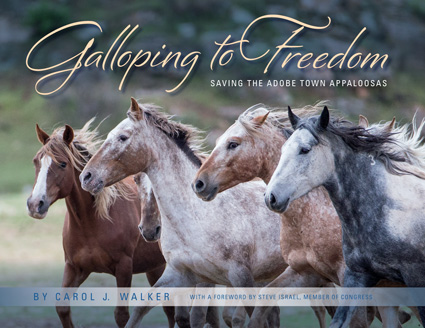Wild Horses: Carol Walker on the Mustang Panel and Signing New Book at Equus Film Festival in NYC This Week
November 17, 2015Wild Horses: Two Events in Colorado for Carol Walker and Galloping to Freedom
January 4, 2016In the Name of Freedom
By Sarah Haas as published in the Boulder Weekly
Managing Wild Horses in the Once Wild West
Carol Walker of Longmont, CO can tell a wild horse by the look in its eyes, an expression of the untamed vastness of the once wild West. For Walker, the author of Galloping to Freedom, a photographic documentation of the plight of wild horses in Wyoming, there is a sense of sadness in that recognition. While she knows wild when she sees it, she also knows that it is tenuous and fleeting.
“In this day and age we are taking more and more of our wild places away to develop, frack and graze the land, all of which is destroying it,” Walker says. “People don’t always realize that there is an impact on human beings that is terrible because we need those wild places as a part of our souls — as a part of our lives and our wellbeing and our planet. People talk about wild horses as a symbol of the West but really they are a part of our land, a part of our planet and a part of our wildlife.”
No longer an open frontier, the West is a patchwork of private and public land that cannot support growing horse populations in tandem with cattle grazing and other industrial uses. Wild horse populations grow at 20 percent a year due to natural reproduction and the release of feral horses onto public lands. When there are too many horses, the Bureau of Land Management (BLM) removes them in roundup events, using helicopters to corral herds into long-term holding facilities.
Walker’s book documents the Checkerboard Roundup of 2014 and follows the journey of a few horses that end up in a Wyoming sanctuary against all odds. Their rescue is due to the fight by a dedicated group of wild horse advocates, including Walker and her organization Cana Projects, a nonprofit dedicated to ensuring the sustainable use of western land and resources through advocacy programs.
But the story of these horses really begins 64 years before the roundup, in 1945, with the passing of the Taylor Grazing Act that established the BLM as the administrator of public lands. For more than three decades, the BLM existed as a land management department, a link between corporate cattle interests and the federal inventory of land, providing below market rate grazing leases to ranchers…(CONTINUED)
Link to the rest of the story:
http://www.boulderweekly.com/article-15410-in-the-name-of-freed.html#commAjax
Link to more about Galloping to Freedom:

